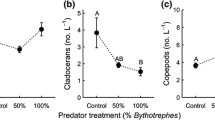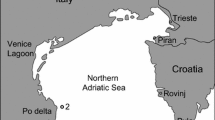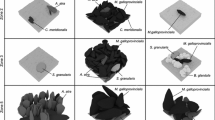Abstract
Studying historic invasions can provide insight into the ongoing invasions that threaten global biodiversity. In this study, we reconsider the impacts of Littorina littorea and Carcinus maenas on the rocky intertidal community of the Gulf of Maine. Past research using invader-removal experiments demonstrated strong top-down effects of L. littorea on algal community structure; however, such removal experiments may overlook the long-term effects of niche shifts and local extinctions caused by invasive species. We considered how a niche-shift in the native littorine, Littorina saxatilis, may change the interpretation of L. littorea impacts. Using a factorial experiment crossing predator presence/absence with L. littorea presence/absence, we found that L. saxatilis is able to exert top-down control on ephemeral algae similar to that exerted by L.␣littorea and that both competition by L. littorea and predation by C. maenas have strong, negative impacts on L. saxatilis. We also found higher predation rates on protected shores and at lower tidal heights and preferential predation on L.␣saxatilis compared to L. littorea. While movement experiments demonstrate that behavioral response to tidal height is the proximate cause of L. saxatilis exclusion from the lower intertidal, our study suggests that the ultimate causes are the additive effects of competition from and predation by invasive species.
Similar content being viewed by others
Abbreviations
- GOM:
-
Gulf of Maine
References
Behrens Yamada SB, Boulding EG (1996) The role of highly mobile crab predators in the intertidal zonation of their gastropod prey. J Exp Marine Biol Ecol 204:59–83
Behrens Yamada SB, Mansour RA (1987) Growth inhibition of native L. saxatilis (Olivi) by introduced L.␣littorea (L.). J Exp Marine Biol Ecol 185:187–196
Behrens Yamada SB, Navarrete SA, Needham C (1998) Predation induced changes in behavior and growth rate of the intertidal snail Littorina sitkana (Philippi). J Exp Marine Biol Ecol 22:213–236
Bertness MD (1984) Habitat and community modification by an introduced herbivorous snail. Ecology 65:370–381
Bertness MD (1998) The ecology of Atlantic shorelines. Sinaeur Sunderland, Massachusetts, 417 pp
Carlton JT (1992) Introduced Marine and estuarine mollusks of North America: an end- of-the 20th-century perspective. J Shellfish Res 11:489–505
Carlton JT (2003) Community assemblage and historical biogeography in the North Atlantic Ocean: the potential role of human-mediated dispersal vectors. Hydrobiologia 503:1–8
Dulvy NK, Sadovy Y, Reynolds JD (2003) Extinction vulnerability in marine populations. Fish Fisher 4:25–64
Elner RW, Raffaelli DG (1980) Interactions between two marine snails, Littorina rudis (Maton) and Littorina nigrolineata (Gray), a predator, Carcinus maenas (L.), and a parasite, Microphallus similis (Jagerskiold). J␣Exp Marine Biol Ecol 43:151–160
Fralick RA, Turgeon KW, Mathison AC (1974) Destruction of kelp populations by Lacuna vincta (Montagu). Nautilus 88:112–114
Ganong WF (1886) Is Littorina littorea introduced or indigenous? Am Nat 20:931
Gilkinson KD, Methven DA (1991) Observations on the sibtidal distributions of the intertidal rough periwinkle, Littorina saxatilis, and the common periwinkle, L.␣littorea, in a shallow embayment in eastern Newfoundland. Can Field Nat 105:522–525
Gotelli NJ, Ellison AM (2004) A primer of ecological statistics. Sinauer, Sunderland, Massachusetts, 510 pp
Grosholz ED, Ruiz GM (1996) Predicting the impact of introduced marine species: lessons from the multiple invasions of the European green crab C. maenas. Biol Conserv 78:59–66
Hadlock Seeley R (1982) Association of Littorina obtusata and fucoid algae: effects of competition with Littorina littorea. Malacol Rev 15:150
Hadlock Seeley R (1986) Intense natural selection caused a rapid morphological transition in a living marine snail. Proc Natl Acad Sci USA 83:6897–6901
Holway DA, Lach L, Tsutsui ND, Case TJ (2002) The causes and consequences of ant invasions. Annu Rev Ecol Syst 33:181–233
Hosmer DW, Lemeshow S (1999) Applied survival analysis: regression modeling of time to event data. John Wiley & Sons, Inc, New York, 386 pp
Johannesson B, Johannesson K (1990) Littorina neglecta Bean, a morphological form within the variable species Littorina saxatilis (Olivi)? Hydrobiologia 193:71–87
Johannesson K (2003) Evolution in Littorina: ecology matters. J Sea Res 49:107–117
Johnson CR, Mann KH (1986) The importance of plant defence abilities to the structure of subtidal seaweed communities: the kelp Laminaria longicruris de la Pylaie survives grazing by the snail Lacuna vincta (Montagu) at high population densities. J Exp Marine Biol Ecol 97:231–267
Levin PS, Coyer JA, Petrik R, Good TP (2002) Community-wide effects of nonindegenous species on temperate rocky reefs. Ecology 83:3182–3193
Levin DA (2003) The ecological transition in speciation. New Phytol 161:91–96
Lubchenco J (1978) Plant species diversity in a marine intertidal community: importance of herbivore food preference and algal competitive abilities. Am Nat 112:23–39
Lubchenco J, Menge BA (1978) Community development and persistence in a low rocky intertidal zone. Ecol Monogr 48:67–94
Mack MC, D’Antonio CM (2003) Exotic grasses alter controls over soil nitrogen dynamics in a Hawaiian woodland. Ecol Appl 13:154–166
Mack RN, Simberloff D, Lonsdale WM, Evans H, Clout M, Bazzaz FA (2000) Biotic invasions: causes, epidemiology, global consequences, and control. Ecol Appl 10:689–710
Menge BA (1983) Components of predation intensity in the low zone of the New England rocky intertidal region. Oecologia 58:141–155
Neter JM, Kutner H, Nachtsheim CJ, Wasserman W (1996) Applied linear statistical models. Fourth edition. Richard D. Irwin, Homewood, Illinois, USA
Reid DG (1996) Systematics and evolution of Littorina. The Dorset Press, Dorchester, Dorset, 720 pp
Rochette R, Dill LM (2000) Mortality, behavior and the effects of predators on the intertidal distribution of littorinid gastropods. J Exp Marine Biol Ecol 253:154–191
Rolan-Alvarez E, Johannesson K, Erlandsson J (1997) The maintenance of a cline in the marine snail Littorina saxatilis: The role of home site advantage and hybrid fitness. Evolution 51:1838–1847
Ropes JW (1968) The feeding habits of the green crab, C.␣maenas (L.). Fish Bull 67:183–203
Sih A, Englund G, Wooster D (1998) Emergent impacts of multiple predators on prey. Trends Ecol Evol 13:350–355
Simberloff D, Von Holle B (1999) Positive interactions of nonindigenous species: invasional meltdowns? Biol Inv 1:21–32
Thomas MLH, Page FH (1983) Grazing by the gastropod, Lacuna vincta, in the lower intertidal area at Musquash Head, New Brunswick, Canada. J Marine Biol Assoc UK 63:737–739
Trussell GC, Ewanchuk PJ, Bertness MD (2003) Trait-mediated effects in rocky intertidal food chains: predator risk cues alter prey feeding rates. Ecology 84:629–640
Trussell GC, Smith LD (2000) Induced defenses in response to an invading crab predator: an explanation of historical and geographical phenotypic change. Proc Natl Acad Sci USA 97:2123–2127
Underwood AJ (1997) Experiments in ecology: their logical design and interpretation using analysis of variance. University Press, Cambridge, 504 pp
Vadas RL, Elner RW (1992) Plant-animal interactions in the north-west Atlantic. In: John DM, Hawkins SJ, Price JH (eds), Plant-Animal Interactions in the Marine Benthos. Oxford, Clarendon Press, pp. 33–60
Vermeij GJ (1982) Environmental change and the evolutionary history of the periwinkle (Littorina littorea) in North America. Evolution 36:561–580
Wares P, Goldwater DS, Koug BY, Cunningham CW (2002) Refuting a controversial case of human-mediated marine species introduction. Ecol Lett 5:577–584
Werner EE, Peacor SD (2003) A review of trait-mediated indirect interactions in ecological communities. Ecology 94:1083–1100
Zavaleta ES, Hobbs RJ Mooney HA (2001) Viewing invasive species removal in a whole ecosystem context. Trends Ecol Evol 16:454–459
Acknowledgements
This research was completed as part of an NSF-sponsored REU program at the Shoals Marine Lab (NSF-REU 0139556). We thank M. Shulman, April Blakeslee and two anonymous reviewers for comments on this manuscript. We thank all the REUs for help with tethering, K. Perez, T. Williamson, and M. Wood for help with subtidal experiments and K. Quinby, L. Shulman, and B. Shulman for help with fieldwork. We also thank M. Shulman and J. Morin for their invaluable advice and assistance.
Author information
Authors and Affiliations
Corresponding author
Rights and permissions
About this article
Cite this article
Eastwood, M.M., Donahue, M.J. & Fowler, A.E. Reconstructing past biological invasions: niche shifts in response to invasive predators and competitors. Biol Invasions 9, 397–407 (2007). https://doi.org/10.1007/s10530-006-9041-5
Received:
Accepted:
Published:
Issue Date:
DOI: https://doi.org/10.1007/s10530-006-9041-5




